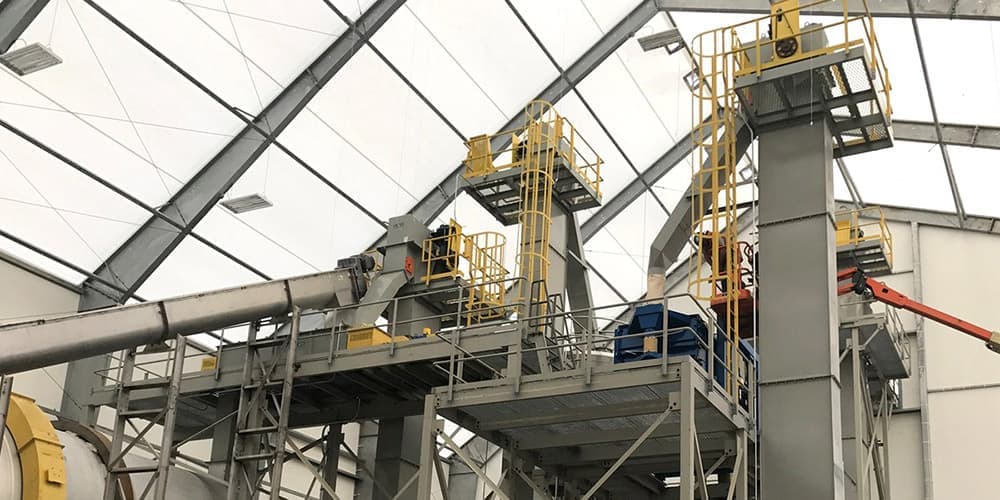Evaluating Bucket Elevator Lifting Solutions
Bucket elevators are an important piece of equipment for efficient vertical transportation of bulk materials. One of the key components to ensure its optimum operation is the lifting device, which maintains the proper tension on the belt or chain. This article looks at the two main hoisting systems used in bucket elevators: screw hoisting and gravity hoisting. We will discuss the principles of operation, advantages and disadvantages of each system, as well as the application requirements that need to be considered when selecting these systems.
Importance of Belt/Chain Tension
Maintaining proper belt or chain tension on the head and tail pulleys or sprockets is critical to the smooth operation of a bucket elevator, whether it is belt-driven or chain-driven. Correct tension ensures minimal belt or chain wear, thus extending its service life. An over-tensioned belt or chain will wear prematurely and put additional stress on the drive components, while an under-tensioned belt may slip on the head pulley, resulting in improper operation or even frequent shutdowns.
Screw Lifting
Mechanism
The screw lift consists of threaded rods or screws located on both sides of the tail pulley. By manually adjusting these screws, the height of the tail pulley or sprocket can be raised or lowered to increase or decrease belt or chain tension. Screw jacks typically use two-bolt ball bearings and can be customized with different bearing seals as required. They are mainly used in belt bucket elevators and small capacity chain elevators.
Advantages
- Cost-effective: Screw hoisting systems are generally less expensive than gravity hoisting systems.
- Simple design: The operating mechanism is simple and easy to understand and operate.
Disadvantages
- Manual adjustment required: Increases the possibility of human error, such as over-tightening or neglecting to make periodic adjustments.
- External mounting: Tailwheel shaft passes through the housing, which can lead to material leakage.

Gravity lift (GTU)
Mechanism
Gravity lift maintains tension by floating the tailwheel shaft in a trough frame and using the weight of the lifting assembly. This type of lift is standard on chain hoists and is particularly suitable for high capacity systems. Gravity lifting uses hardened iron or wear-resistant block and sleeve bearings that are located inside the tailwheel housing, require no lubrication, and can be serviced or replaced through an access door.
Advantages
- Automatic Tension Adjustment: Gravity lift automatically monitors and adjusts tension, reducing the need for human intervention.
- Durable and Low Maintenance: The system is extremely durable and requires minimal maintenance.
- No Material Leakage: Sealed design prevents dust and material leakage for dust-sensitive environments.
Disadvantages
- Higher cost: Complex and robust design makes gravity lift more expensive than screw lift.
- Application-specific: Not suitable for belt elevators, which require constant tension to avoid slippage.

Comparison Summary
| Feature | Screw Take-Up | Gravity Take-Up (GTU) |
|---|---|---|
| Best For | Belt Bucket Elevators or Low-Capacity Chains | Chain Bucket Elevators |
| Advantages | Lower Cost | Extremely Robust, Self-Monitoring, Low Maintenance, No Material Leakage |
| Disadvantages | Requires Manual Adjustment, Potential for Material Leakage | Higher Cost |
Selection Considerations
When selecting a suitable hoisting solution, the following factors need to be considered.
1. material characteristics: particle size, humidity, viscosity, temperature, etc.
2. working environment: temperature, humidity, dust and other environmental factors.
3. Production capacity: the required conveying capacity.
4. Maintenance management: the ease of maintenance of the equipment.
5. Space constraints: Availability of installation and operating space.
6. Budget: Initial investment and long-term operating costs.
7. safety features: the need for special safety protection devices.

Conclusion
Choosing the right lifting device is critical to maintaining belt or chain tension, ensuring efficient operation and extending the life of the equipment. Screw hoisting provides a cost-effective and simple solution, while gravity hoisting offers durable, low-maintenance performance for high-capacity chain hoists.
When making your choice, it is recommended that you.
1. Fully evaluate your specific application requirements and operating environment.
2. Consider long-term operating costs, not just the initial investment.
3. Consult with a professional equipment manufacturer or engineer for targeted advice. 4.
4. consider the possibility of future expansion or upgrade.
For more information on selecting the right hoisting unit or other hoist design considerations, feel free to contact TONGLI, a trusted bucket elevator manufacturer since 1958.

